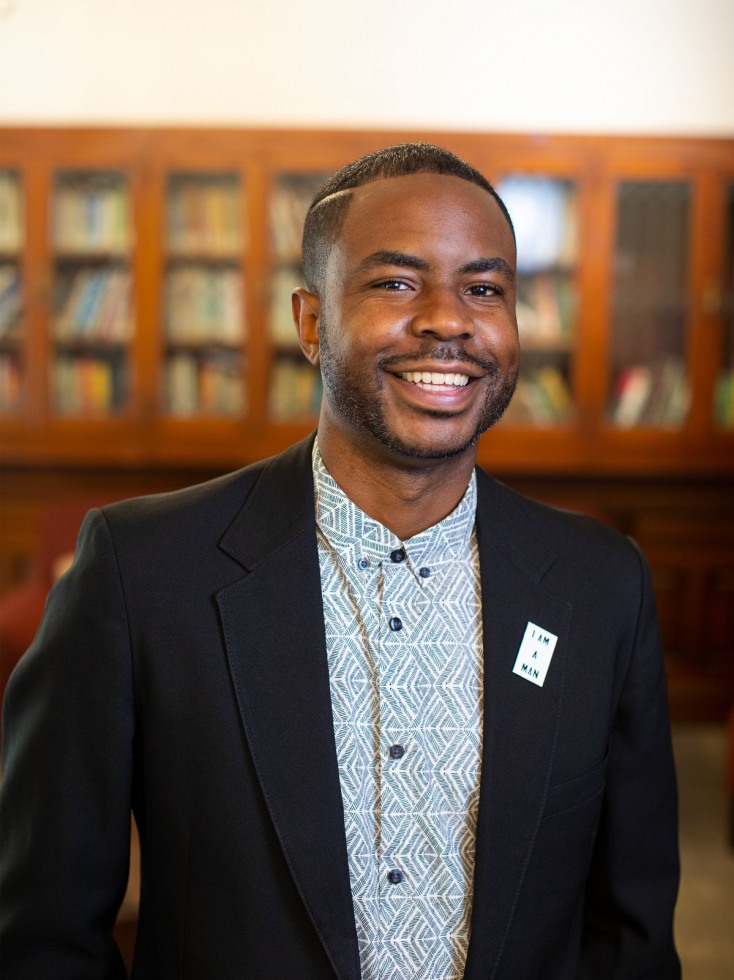PROVIDENCE, R.I. [Brown University] — For Vincent Harris, home is where you can be your authentic self.
“When I think of home, I think of inclusivity and equity and acknowledging the unity in our differences,” Harris said. “When I can see myself truly as who I am, and then show up in places unapologetically without feeling like I'm going to be judged or not appreciated, then in that space I'm truly being welcomed into a home.”
As the new associate dean and director of the Brown Center for Students of Color, Harris brings a decade of experience creating inclusive university spaces where students from historically underrepresented groups thrive. As a coordinator at the Black Male Leadership Initiative at Louisiana State University, he established policies and practices that increased the graduation rate and heightened the academic success of Black male undergraduates. Later, Harris completed a fellowship at the Harvard College Women’s Center, where he promoted the growth and development of women students.
Most recently, Harris served for five years as the inaugural director of the Male Success Initiative at California State University – Fullerton, one of the first programs in the nation to provide a dedicated space for supporting men of color. Under Harris’ tenure, the initiative became a model of a student support community that boosted academic success while creating a culture that promoted racial and gender inclusivity.
“It was certainly a transformative experience in my career,” Harris said. “We were not only able to create a department that developed scholarship resources for men of color and that removed academic barriers for them, but also one that gave them the language to understand the complexities of gender through forming an inclusive brotherhood.”
For Harris, directing the BCSC is an opportunity to achieve his goal of providing “structure and care” for all students of color in collaboration with a dedicated community of staff members and students — all while building upon the longstanding legacy of the center.
“I can't create the vision of what the BCSC is alone,” he said. “It has to include undergraduate students, graduate students and medical students of color. It has to include the current team members and alumni. It has to include other administrators and faculty on campus. That's what I think cultivates a sense of home — this shared visioning of what it represents.”
In an interview, Harris shared his thoughts on the experiences and interests that animate his work, the reasons he came to Brown, and the vision he has for the BCSC.
Q: What experiences have been most formative to your work?
I think I have to start that question with where I'm from. Growing up in Birmingham, Alabama, was a very formative experience for me. I consider Birmingham one of the heartbeats of the Civil Rights Movement. Ironically, it is the pain and the racial disparities of that city that I would adopt from it — the resilience and the grit of its people, our leaders who are also some of my family members, who actually showed up to some of the marches to strive for a more inclusive and better future. That resilience, that grit, is definitely what I see in some of my work and in how I show up to the profession.
I was grateful to know in college that I wanted to pursue higher education as a profession, but I first entered education through Teach for America, where I taught fifth- and sixth-grade reading, language arts and social studies. It was a moment in my life where I saw education from the ground up. I understood the pedagogy, I understood the policies, I understood standardized testing, and most importantly I understood the cultural norms that not only shaped the mindsets of our teachers, but limited the mindsets of our students. I discovered through this experience that education could also be used as a tool to crack open possibilities for our students — for them to see that their cultural norms and their environments can actually be used as fuel for them to get where they want to be.
Q: What interests drive your work as a campus life leader and researcher in higher education?
Literature on men of color and on gender can be very one-size-fits-all. My research is largely about how Black men can navigate higher education spaces, but as the fullness of my own identity started to show up more in my work, I also became interested in how Black men who identify as gay, bisexual, queer or questioning can navigate those spaces in higher education. We are oftentimes the ones who are pushed to the margins and told by our institutions, "Well, you figure it out, because our supporting your gender and your ethnicity separately should be enough.”
But no — we need to also understand and support these intersectional identities. This understanding of an inclusive brotherhood, one that holds space for brothers who identify along the GBTQ spectrum, has been so important to me. As a Black gay man who grew up in the Deep South, I know firsthand what it feels like to be a student who has been on the margins. When we limit the ways in which we view masculinity, it restricts how we show up. But when we start new traditions and new ways to support students of color, our spaces can be ones in which you can remove the mask and can show up as your full self.
